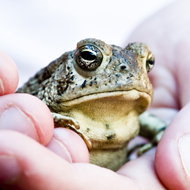Common toad declines by nearly 70 per cent

Volunteers carry over 800,000 toads to safety each year in the UK and Switzerland. But despite these efforts, they have suffered huge declines.
New research shows the common toad has declined by 68 per cent over the past 30 years in the UK.
Conservation scientists from the charity Froglife teamed up with Swiss researchers to analyse millions of records gathered by volunteers during its annual 'Toads on Roads' patrol, during which thousands of wildlife lovers in the UK help amphibians migrating to their breeding ponds across busy roads.
Volunteers carry over 800,000 toads to safety each year in the UK and Switzerland. But despite these efforts, scientists have found toad populations have declined rapidly and continuously in both countries since the 1980s. Their findings have been published in the journal PLOS ONE.
Some areas, such as the south of England, have seen particularly sharp declines. The north, including northern counties and Scotland, have also seen significant declines in the past two decades. In the west (including Wales, south west and west England), populations have fallen but remained stable for the past 10 years.
All in all, scientists believe hundreds of thousands of toads may have disappeared from the countryside in the past three decades.
It's not clear why numbers are falling so rapidly, but likely culprits are thought to be changes in farming practices, loss of ponds, increasing urbanisation and more deaths on roads as traffic volumes increase. Climate change could also have a role as research shows milder winters are harmful to hibernating toads.
Dr Silviu Petrovan, conservation co-ordinator at Froglife, called the research "really worrying".
"Toads are extremely adaptable and can live in many places ranging from farmland and woodland to suburban gardens. They are also important pest controllers eating slugs, snails and insects and are food themselves for many of our most likeable mammals such as otters and polecats.
"Without the efforts of the thousands of volunteers that go out and move amphibians across busy roads we would have no idea that these declines had occurred and the situation could be much worse. One thing that is clear is that we need to do more to look after our environment in order to protect the species that depend on it."
Paul Edgar, senior amphibian and reptile specialist from Natural England, added: "We need to continue to build good quality habitat links across the wider landscape if we are to offer opportunities for this species to recover. We’re working hard to do this through measures such as Countryside Stewardship in the rural setting, and ensuring good quality Green Infrastructure is included in new developments.
"This paper reinforces the vital positive role that the public play in both protecting and recording data about our wildlife. We need to build on this engagement to further help us collaboratively reverse these declines as a matter of urgency."



 The BSAVA has opened submissions for the BSAVA Clinical Research Abstracts 2026.
The BSAVA has opened submissions for the BSAVA Clinical Research Abstracts 2026.